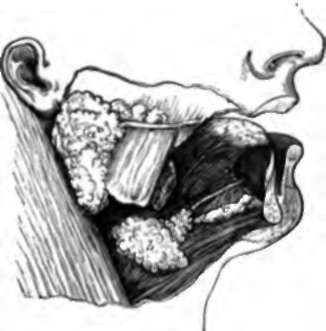65. Digestive Fluids
Description
This section is from the book "Animal Physiology: The Structure And Functions Of The Human Body", by John Cleland. Also available from Amazon: Animal Physiology, the Structure and Functions of the Human Body.
65. Digestive Fluids
The first substance added to the food is the saliva, which is furnished by three pairs of compound sacculated or lobulated glands葉he parotid, the submaxillary, and the sublingual. The parotid gland is the largest, and is named from its nearness to the ear, lying as it does in the hollow between the ear and the lower jaw. It turns over the hinder border of the jaw; and from this part of it issues a duct葉he duct of Stenson様arge enough to admit a crow-quill, and opening into the mouth through the cheek, opposite the second molar tooth of the upper jaw. The submaxillary gland, about the size of a large prune, lies beneath the lower jaw, and its duct;葉he duct of Wharton熔pens under the tongue. The termination of this duct, along with its fellow, may be seen in a looking-glass, making a little swelling on the lower part of the fraenum or bridle of the tongue. At the same time will be seen on each side of the fraenum, between the tongue and the jaw, an elevation about the size of an almond, with the outlines of the sublingual gland seen through the mucous membrane. It has several ducts, some of which open separately, while others fall into Wharton's duct Besides these large glands, there are numerous others of small size which open into the mouth, particularly the buccal glands, a series of structures the size of lentils, scattered under the mucous membrane of the lips and cheeks, and a smaller set of glands near the tip of the tongue; but they are engaged in the secretion of a mucus which has little or nothing to do with digestion. The saliva has a slightly alkaline reaction, and its most important ingredient, besides water, is a nitrogenous substance called ptyalin which has in a very high degree the property of converting starch into grape-sugar, provided that the solution be alkaline. So powerful is this action, that a notable amount of the starch taken into the mouth as food is converted into dextrin or sugar before being swallowed; and when the food is of a tenacious consistence, masticated and taken in quantity, a large part of it may escape for a time the contact of the acid gastric juice, and have a much larger quantity of its starch acted on in the stomach. The conversion of starch into sugar, however, is neither the only nor even the principal use of the saliva, as is proved, first, from the salivary glands being well developed in carnivorous animals, which, in the natural state, use no starch in their food; and, secondly, from the amount of saliva mixed with the food bearing a direct proportion to its dryness預 circumstance which shows that it is important as a moistener.

Fig. 63. Salivary Glands, a, parotid; b, submaxillary; c, sublingual.
66. In the stomach the food causes a flow of gastric juice, an acid secretion with a peculiar nitrogenous principle, called pepsin. Various acids may be developed among the contents of the stomach, the most important of which are lactic, acetic, and butyric; but these are generated accidentally in the processes of change, and it has been shown by investigations, both on the lower animals and on man, that free hydrochloric acid is that which is secreted by the glands of the stomach. The use of the acid, however, appears to be to aid the pepsin; the peculiar properties of that substance being exhibited in none but acid solutions: and for this purpose any acid suffices. Pepsin is obtainable from the mucous membrane of the stomach of animals by the action of water. It is the active principle in the rennet used in manufacturing cheese; rennet being a preparation of the mucous membrane of a calf's stomach, used on account of the property, which pepsin possesses, of curdling casein. In an acid solution, at a temperature of about 100°F., pepsin dissolves coagulated albumen, and renders it incapable of being coagulated again by heat. It acts in like manner on nearly all albuminoids, and the substances into which it converts them are called peptones; but the chemical nature of these is not thoroughly understood. It likewise dissolves gelatin and gelatiniferous tissue, converting them into a solution which does not jelly on cooling; but it has no action on either oil or starch. The gastric juice therefore digests none but nitrogenous substances.
Continue to:
